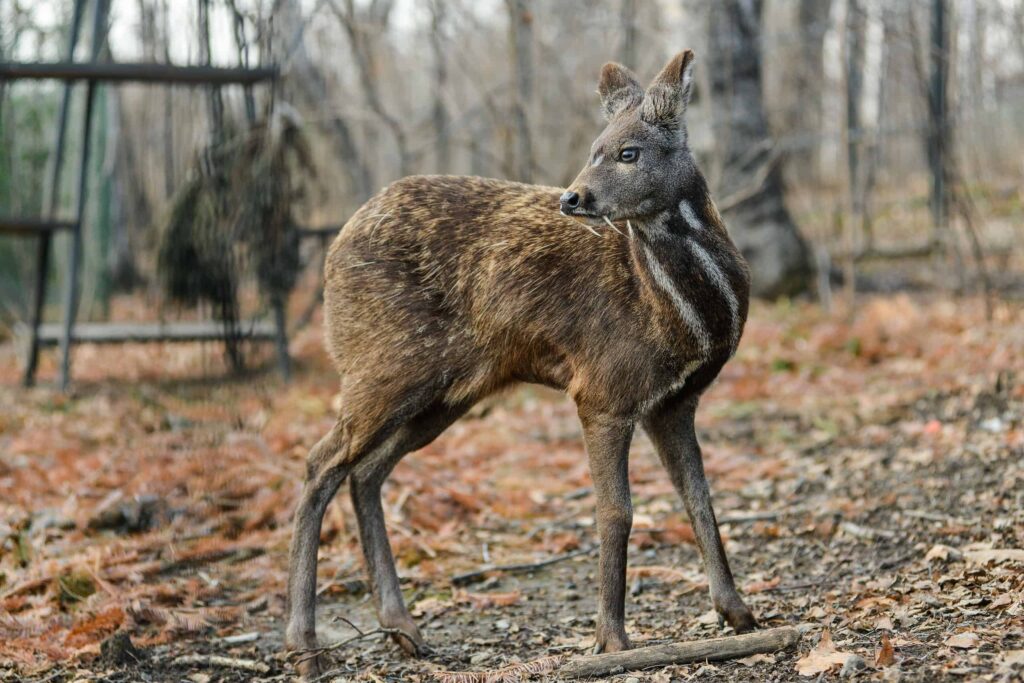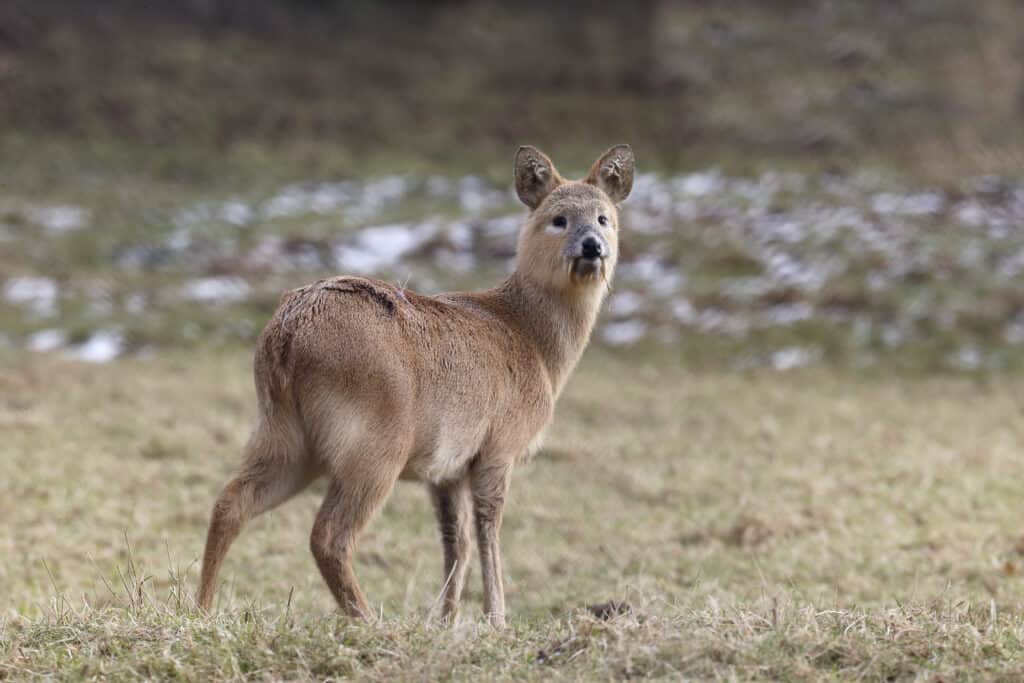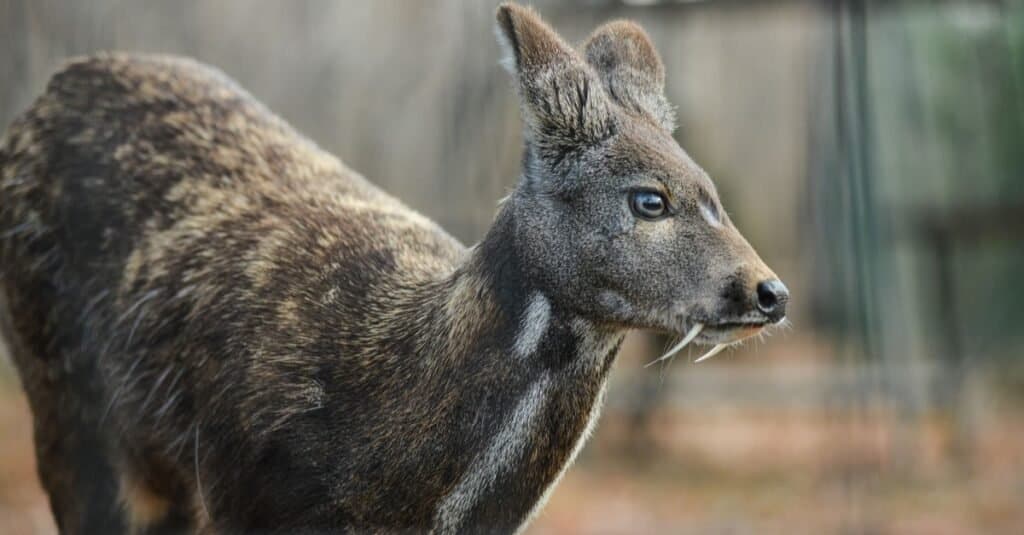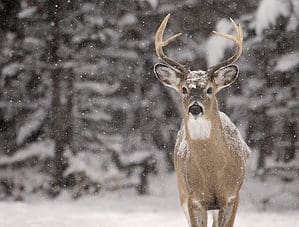Smaller deer species can be quite difficult to tell apart. In fact, some of them are so hard to differentiate that animals outside of the deer family Cervidae are often confused for and named after them. That is the case with the musk deer. However, if you compare the musk deer vs. water deer, you’ll see that some elements of the two are so alike that you need a cheat sheet to know which one is which.
After all, how many small, fanged, four-legged herbivores are running around Asia? In this article, we’re going to compare the musk deer and water deer so you can see what makes them unique! You’ll have a good idea of how to tell these mammals apart!
Comparing a Musk Deer and a Water Deer

The musk deer is a dark brown mammal from the Moschidae family that lives in a large portion of northeast Asia and the Indian subcontinent.
©Suvorov_Alex/Shutterstock.com
| Musk Deer | Water Deer | |
|---|---|---|
| Size | Weight: 15-40 lbs Height: 1.8-2.2 ft Length: 2.5-3.2 ft | Weight: 20-31 lbs Height: 1.5-2 ft Length: 2.5-3.3 ft |
| Morphology | – Dark brown coat that can have lighter brown mixed into it – Some subspecies have a lighter color on the underside – Males possess two large fangs that measure up to 4 inches long – Fangs are used in competition with other males – Females lack fangs – Hind legs longer than forelegs – Male Siberian deer do not have antlers – Males have a musk gland for which they are named | – Golden brown coat and light-colored undersides – Possesses a long neck – Lacks antlers – Possesses inguinal glands for scenting – Has long, prominent tusks or fangs that can measure up to 3 inches long – Females have short fangs that measure less than an inch long – Rear legs are longer than forelegs |
| Species | – Moschus genus – A common variant is Moschus moschiferus, the Siberian musk deer – Other variants are located in the Himalayas, eastern Asia, and China – Seven species exist – From family Moschidae rather than Cervidae – Not a true deer | – Hydropotes inermis – Cervidae family – Capreolinae subfamily – Two subspecies, one in China and one in Korea |
| Range | – Northeast Asia, Southeast Asia, southwest China, and the Himalayas – Found in countries like Russia, India, Nepal, Vietnam, and China – Prefer to live in forested environments – Rarely found near human settlements – Often hunted for its musk gland | – Native to eastern China, North Korea, and South Korea – Introduced in Great Britain in the 19th century – Found most often in the lower portion of the Yangtze River and the west coast of North and South Korea – Prefer to live near rivers and swamps, but also lives in grasslands and mountains |
| Diet | – Survives on lichens, tree bark, tree shoots, honeysuckle, herbaceous plants, and even coniferous needles – During the winter, they most often eat lichens | – Grazers that consume grasses, herbs, forbs, and more |
The 5 Key Differences Between a Musk Deer vs. Water Deer
The greatest differences between musk deer and water deer are their coloration, species, and range. While the musk deer is a dark brown mammal from the Moschidae family that lives in a large portion of northeast Asia and the Indian subcontinent, the water deer is a true deer from the Cervidae family with golden-brown hair found in the eastern part of China and the west coast of North and South Korea.
The physical differences between these mammals are very small and subtle, but we can parse them. Also, they have other qualities that set them apart. Let’s take a closer look at these deer and sort them out.
Musk Deer vs. Water Deer: Size

Water deer stand 2 feet tall and measure up to 3.3 feet long.
©Erni/Shutterstock.com
Musk deer and water deer are roughly the same sizes. However, the musk deer has a greater variation in weight, often tipping the scales are 15 to 40 pounds, while the water deer weigh between 20 and 31 pounds.
Water deer stand 2 feet tall and measure up to 3.3 feet long, but musk deer stand 2.2 feet tall and usually measure up to 3.2 feet long. All told, these mammals are very similar in size and weight, with only small variations between them.
Musk Deer vs. Water Deer: Morphology
The musk deer and water deer have similar bodies, but they do have some important variations. For example, the musk deer has a dark brown coat, but the water deer often has a golden brown coat and light undersides. The water deer also has an unusually long neck compared to other deer of its size.
Both creatures have hind legs that are longer than their forelegs and lack antlers. Male musk deer have tusks, but females do not. However, both male and female water deer have tusks. Female water deer have short fangs or tusks less than an inch in length. Yet, the tusks of the musk deer are up to 4 inches long, while those of the water deer measure only 3 inches in length.
The musk deer also have a musk gland that they use for marking territory. Although water deer have inguinal glands for scenting, their scent is not as prominent, and they are not hunted for their scent.
Musk Deer vs. Water Deer: Species

The musk deer eats a variety of different plants, such as lichens, bark, plants, tree needles, and shoots.
©Suvorov_Alex/Shutterstock.com
The musk deer are not true deer, but water deer are true deer. Instead, musk deer are a member of the Moschidae family instead of the Cervidae family. This genus has seven species, and they have fractured populations throughout Asia.
The water deer is from the Cervidae family and the Capreolinae subfamily, and they have two subspecies. They are the Chinese water deer and the Korean water deer. These deer are very different in terms of where they belong on a phylogenetic tree.
Musk Deer vs. Water Deer: Range
The musk deer and the water deer can both be found in Asia, but they live in different parts. For example, the musk deer is found in southwest China, the Himalayas, and Southeast Asia. Musk deer live in countries like Nepal, India, China, Russia, and Vietnam. They stay away from human areas, and they live in forested environments.
However, the water deer can only be found in eastern Asia and the U.K. These days, the water deer is rare outside of the mouth of the Yangtze River on the eastern coast of China along with the western coast of the Korean Peninsula. However, the deer was introduced to Great Britain in the 19th century and has since established a population of over 2,000 animals.
These mammals prefer to live near water, especially by rivers and swamps, but they can also live in grasslands and mountains. While both animals live in Asia, it’s unlikely that you’ll see them in the same spot.
Musk Deer vs. Water Deer: Diet

Water deer mostly survive on grasses, herbs, and forbs.
©Wirestock Creators/Shutterstock.com
Musk deer have a wider variety of foods in their diet than water deer. The musk deer eats a variety of different plants, such as lichens, bark, plants, tree needles and shoots, and more! Yet, water deer mostly survive on grasses, herbs, and forbs. They are grazers that spend a large portion of their day looking for food.
The musk deer and water deer look very similar. However, they are different animals that don’t even belong to the same family. Yet, even with all the information this article provides, it may still be challenging to tell them apart.
Up Next:
- Fallow Deer vs Whitetail Deer
- Deer vs Reindeer: What Are 8 Key Differences?
- Mule Deer vs White-tail: 5 Key Differences Explained
- Moose Vs Deer: What Are the Differences?
The photo featured at the top of this post is ©
Sources
- Science Direct, Available here: https://www.sciencedirect.com/science/article/abs/pii/S0006320702001593
- U.S. Fish & Wildlife Service (1970) fws.gov/species/musk-deer-moschus
- Game & Wildlife Conservation Trust, Available here: https://www.gwct.org.uk/research/long-term-monitoring/national-gamebag-census/mammal-bags-comprehensive-overviews/chinese-water-deer/
- World Wildlife Fund, Available here: https://www.worldwildlife.org/pages/musk-deer
Thank you for reading! Have some feedback for us? Contact the AZ Animals editorial team.






